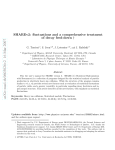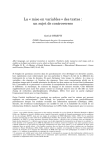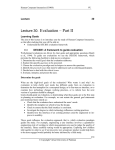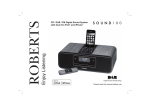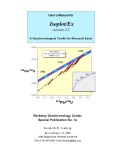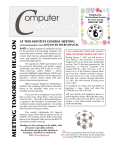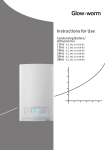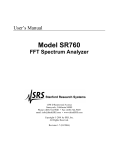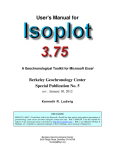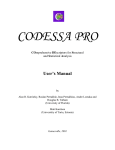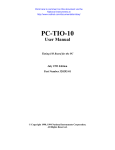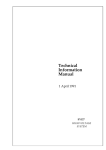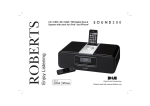Download The Noise Lab
Transcript
The Noise Lab Chris Takacs Chapter 1 Introduction 1.1 Goals of this lab Our goal is to do a precision measurement of kb , Boltzmann’s constant. To find Boltzmann’s constant, we measure voltage fluctuations known as Johnson Noise over a resistor using a Spectrum Analyzer (SA). The SA is a complicated piece of equipment and the measurements we want to perform will push their limits. Thus, we need to understand how these instruments work at their most basic level. The first section is about understanding the properties of Johnson Noise as well as other Random Processes. Dealing with random processes is very different than deterministic systems. Developing tools to work with such systems is useful in a wide variety of fields. We will quote the properties of Johnson Noise and leave the physics of this phenomena to the references. The reason for this is simple: there are already excellent derivations of this phenomena and I want to focus myattention to developing tools to understand these derivations. The tools are more similar to those in quantum and statistical mechanics than those of classical mechanics. The second section will be focused on creating a set of tools in the frequency domain. We start this section off with a review of Fourier Transforms and their properties. The emphasis is not on carrying out tedious calculations, but using the properties of Fourier Transforms and graphical techniques to quickly find the answers. This is to help build physical intuition when dealing with the frequency domain. The third section is about taking data with the SA . The goal of the previous two sections was to develop the conceptual basis to understand the workings of the SA amplifier. We start with developing a model based on the first two sections, access the limitations and capabilities of each instrument and create a testing regime. The final section is a brief overview about extracting kb . Most of the fitting is done with a simple Mathematica script provided with the lab. From the 1 data, you will determine the useful range of the instrument. Also, additional directions for the lab are suggested. 1.2 What I expect of you This is an ambitious lab. As such, I feel obligated to list the things expected of you before the lab starts: • Prior knowledge of analog electronics (Phys 127A)1 • Willing to put the effort in to learn these skills • Read the lab and work the exercise before the lab starts Here is a disclaimer: many of the exercises in this lab have open ended answers. This is done so you can show your depth of understanding - which is what determines your grade. With that said, not every exercise is required nor are all exercises of equal difficulty. Exercises that are mandatory will be marked with a ‘*’. There are a fair number of exercises. If you are having difficulty answering a question, move on to the next if possible and come back to it later. The main point is to understand the concepts of each section. I expect that you will work through the lab in a mostly linear manner. There is a substantial amount of theory in the beginning but I believe this is unavoidable (Approximately half the lab). Given more time, the first day of the lab, you would sit down with the SA and start trying to make these measurements for yourself. Then, motivated by the strangeness of the results, learn the tools outlined the theory section. Unfortunately, we don’t have enough time for this. We pretty much have to do the experiment correctly the first time through. My hope is that the theory and background allow you to quickly understand the SA; so the equipments don’t seem like a mysterious black box. The final lab report is to be focused on the extraction of kb . The first goal is to be clear and concise. The second goal is to prove your results. This is done by explaining the subtleties of extracting the data, detailing in what range your results are valid, and discussing the assumptions (both good and bad) that you made about the instrument. This lab is not about getting the right answer... it is about approaching the problems in an organized, methodical way. 1.3 What you can get out of the lab This is the exciting part. This lab is an excellent example of the way experimental science is conducted; most of the time is spent understanding the equipment. Taking the real data require only a small fraction of the total lab time. Also, the theory and techniques introduced in this lab are used in almost all branches of physics and engineering. 1 This lab assumes a complete knowledge of analog presented at the level of Phys127A. 2 My hope is that no one particular step is too difficult and that each part of the lab builds on itself. This is the way it happens in research and industry. Great advances are the result of many small successes built upon themselves. 3 Chapter 2 Random Processes 2.1 Qualitative Description of a Random Process The term ‘Random Process’ (also referred to as a ‘Stochastic Process’) is a generic term for the output of a system that is not completely deterministic in nature. This output can be anything measurable: position, voltage, current, etc. In classical systems, we understand the physics of most systems well-enough to write down a set of equations that will correctly give the exact behavior of the system given knowledge of the previous states of the system1 . However, we generally do not have this information nor could we solve the equations even if we did. Thus, our goal is to find ways of describing the general properties of systems without requiring such detailed knowledge. Let’s start with describing Johnson noise. Given a resistor with resistance R and at a fixed temperature T , a randomly fluctuating voltage is present across the resistor even though no voltage is applied. These voltage fluctuations result from random movements of electrons throughout the material. The variance of the voltage signal is hV 2 i = 4kb T RB (2.1) where the brackets denote an average. ‘B’ is the bandwidth of the system, a property we will be discussing later. For now, it is only important to know that bandwidth is inversely proportional to the sampling time. Also, there is a filter2 that prevents any frequency higher than 2T1 s . On average, these voltage fluctuations will average to zero. *Exercise 1: How much power can you extract from these fluctuations? Why? 1 Of course, this is not true in Quantum systems is a perfect filter at the Nyquist sampling frequency 2 This 4 0.1 0.08 0.06 0.04 0.02 0 −0.02 −0.04 −0.06 −0.08 −0.1 Figure 2.1: Instantaneous voltage measured over a resistor sampled at a rate Ts . Arbitrary units on the vertical axis. The formal derivation of Johnson noise is more detailed and requires some of the tools that will be developed throughout the lab. Thus, much of the information in this section will be given and not derived so as to not obscure the qualitative features of random processes. Figure 2.1 shows the sampled voltage fluctuations of a resistor. The sampling time is Ts and the scale is in arbitrary units. For the purposes of this qualitative analysis, we are only concerned with scaling of the vertical axis with sampling rate. Most of the sampled points are confined within the first few standard deviations. The histogram of this data is in figure 2.1. We see that the distribution approaches a Gaussian; the reasons for this are explained in the formal derivation of Johnson noise. Here is the key statement: while the probability distribution of the signal seems to be well defined, there is no relation between successive samples. If we decrease the sampling time (increase the bandwidth) as in figure 2.1 we see the variance increase. However, there is no real difference in the structure3 of the signal. The value of each sampled point is independent of the value of 3I use the word ‘structure’ to denote a visual pattern 5 140 120 100 80 60 40 20 0 −0.1 −0.05 0 0.05 Figure 2.2: Histogram of the time series. 6 0.1 0.1 0.08 0.06 0.04 0.02 0 −0.02 −0.04 −0.06 −0.08 −0.1 Figure 2.3: Time series with decreased sampling time. 7 Figure 2.4: Ts low enough to see the finite response time of the system. all previous samples. This, coupled with the Gaussian probability distribution, leads to the term ‘white noise’ which will be explained later. In the limit Ts → 0, hV 2 i → ∞ ; implying that the system is fluctuating ever more wildly. This is an odd result. It means that the voltage over this resistor is always fluctuating from −∞ to −∞ constantly. Of course, this is an unphysical. In practice, there is some upper bound on how fast the resistors voltage can fluctuate4 . We see in figure 2.1 what happens when the sampling time is on the order of the response time of the system. The voltage at one point in time becomes correlated with the voltages at later times. This should not be confused with the system being deterministic. If we wait long enough, we will have no idea where the system will be. We only have a way of predicting likely values for the system at short timescales. By describing the random process through the correlations it posses at different timescales, we can characterize a random process. 4 The derivation of Johnson noise goes deeper into this idea. The mobility of electrons in the material will set this bound. 8 2.2 Random Processes – A More Formal Definition This section is going to give a more quantitative introduction to random processes based on the ideas of probability distributions, moments, and correlation functions. This is an introduction to the subject and not an exhaustive treatment. The math introduced is designed to elucidate the physics and interpretation of results later in the text. References are given in the end and I urge the reader to consult them if needed or interested. In general, a random processes has an output that is dependent on a variety of inputs which may also be random. The formalism that we are going to develop will explain the temporal characteristics of random process as a collection of random variables. For the most part, we are going to be interested in gaussian random processes as they represent many physical systems. However, the formalism for all of them is the same. For the systems of interest to us, we can describe these outputs as random variables. Before discussing random processes, lets go through random variables. 2.2.1 Probability Basics For this section of the discussion, we start with random variable X. This variable has no time dependence. The Probability Density Function (PDF) describes the probability of X taking on the specific value ‘x’ and is given by ρX (x). This function will be real, positive, and must obey the normalization condition AllX X ρX (x) = 1 (2.2) x . If the system has a continuous set of output states running from −∞ to +∞, we can rewrite the sum as the integral Z +∞ ρX (x) dx = 1 (2.3) −∞ . When dealing with a system with a continuous set of output states, we always measure the system in some range. The probability of the system being in the range xmin to xmax is Z xmax ρX (x) dx (2.4) P (xmin ≤ x ≤ xmax ) = xmin . Note that the function ρX (x) gives us a great deal of information about the most probable state; it contains no information about future or past states. We will use the PDF in evaluating the expectation value5 of random variables. 5 This is roughly the same idea as you have seen in quantum mechanics 9 2 1.8 1.6 1.4 1.2 1 0.8 0.6 0.4 0.2 0 −1 −0.5 0 0.5 1 1.5 2 Figure 2.5: Unform PDF of A. There is another function that is useful when working with random variables called the Probability Distribution Function and is defined as Z x FX (x) = PX (−∞ ≤ x) = ρX (x́) dx́ (2.5) −∞ . Note that this function will be a monotonically increasing function of x starting at 0 that tends toward 1 as x → ∞. Example – Functions of Random Variables Lets do a practical example. We often need to construct new random variables from other random variables. Explicitly, if the random variable A gives us the value a, we want the random variable B to return the value b (i.e. a mapping from one to the other). Starting with the random variable A with the PDF shown in figure 2.2.1, lets find the transformation to the new random variable B where B = T(A) = mA + z (2.6) where T(A) is the transformation function relating random variables A and B, m(m ≥ 0) is the slope of a line and z is the offset. The transformation function 10 maps the value a from the random variable A to the value b giving us b = T(a) (2.7) a = T−1 (b) (2.8) . Inverting the equation, The probability distribution functions for A and B yield the constraint FB (b) = FA (a) which can be written as Z Z b ρB (b́) db́ = −∞ a ρA (á) dá = (2.9) Z T−1 (b) ρA (á) dá (2.10) −∞ −∞ This expression can be rewritten to give a function for the PDF of B (using the Leibniz Rule) −1 da T (b) = ρA (a) ρB (b) = ρA (2.11) db db *Exercise: Explain why the above constraint on the probability distribution function is correct. Exercise: Go through the steps of this example explicitly by using the Leibniz rule. *Exercise: What properties should the transformation function have in order to give sensible results? Could I have specified m to be negative and had a sensible answer? *Exercise: Construct a Gaussian random variable from the random variable A defined previously. Exercise: Most programming languages (and spreadsheets) have a built-in function for generating a numbered from 0 to 1 (i.e. The random variable A). Using the results from the previous exercise, write a short program6 that takes a random variable and generates a Gaussian distribution. Verify the output approaches a gaussian by making a histogram of the output and fitting. Dealing with multiple random variables is crucial to understanding Random Pocesses. The formalism is simliar to that of a single random variable with a few additions. First, we define the joint probability density function of two7 6 Use 7 Of anything: Excell, Mathematica, MATLAB, etc. course, there can be any number of random variables. We deal with two for simplicity. 11 random variables Q and R written as ρQR (q, r). The joint PDF can, in general, be dependent on both variables. An examples of a dependent joint PDF is ρQR (q, r) = u(x) u(y) x e−x(y+1) (2.12) where u(x) is the unit step function8 . We can identify a joint PDF as being formed from independent random variables if we can factor ρQR (q, r) as ρQ (q)ρR (r). The joint PDF must also satisfy the normalization condition Z +∞ −∞ Z +∞ ρQR (q, r) dq dr = 1 (2.13) −∞ The joint probability distribution function is defined as Z r Z q FQR (q, r) = ρQR (q́, ŕ) dq́ dŕ −∞ (2.14) −∞ Example – Adding Random Variables Let W be a random variable defined as W =X +Y (2.15) where X and Y are independent random variables with arbitrary PDF. Again, we start with the definition of the distribution function Z +∞ Z w−y ρXY (x, y) dx dy (2.16) FW (w) = P (X + Y ≤ w) = −∞ x=−∞ The instantaneous value of W is w = x + y. Using the fact that X and Y are independent, we can rewrite the distribution function as Z +∞ Z w−y FW (w) = ρY (y) ρX (x) dx dy (2.17) −∞ x=−∞ Using Leibniz’s rule, we find the PDF Z +∞ fW (w) = fY (y)fX (w − y) dy (2.18) x=−∞ is the convolution of the density functions. *Exercise: Find the variance of a random process H = K + L where K and L are gaussian random variables hKi = hLi = 0, hK 2 i = σK 2 , and hL2 i = σL 2 . 8 ‘Unit step function’ is the name commonly used in engineering literature. In physics, it is usually refered to as the ‘heavyside function,’ Θ(x). 12 Having the tools to understand multiple random variables is important in understanding, among other things, the central limit theorem. This is an important component in the Johnson Noise derivation and in many other phenomena. The central limit theorem states that the sum of N independent random variables approaches a Gaussian probability distribution in the limit as N → ∞. Exercise: Go through the proof of the central limit theorem and explain: why it works and why N → ∞ makes this gaussian. Going through the next section will be helpful in following the derivation. 2.2.2 Moments of a Random Variable The expectation value of a random variable X (with a continuous set of output states) is defined as Z +∞ X = hXi = E[X] = x ρX (x) dx (2.19) −∞ . There are a number of different conventions used to denote the expectation value. These generally vary by field. We can define the nth moment of the random variable as Z +∞ n n hX i = E[X ] = xn ρX (x) dx (2.20) −∞ and the nth central moment of the distribution as Z +∞ h(X − hXi)n i = E[(X − X)n ] = (x − hXi)n ρX (x) dx (2.21) −∞ . Some of the moments have common names. The 1st moment is the mean value of a function. The second central moment is the variance of a function. Many of the moments may vanish for symmetry or other reasons. In the case of Gaussian random variables, every central moment beyond the second vanishes – a property that characterizes gaussian random variables. *Exercise: Prove that the variance = h(X −hXi)2 i can be rewritten as hX 2 i − hXi2 using the definition of the expectation value. The expectation values can also be defined for multiple random variables. The joint moments are defined as Z +∞ hX n Y m i = xn y m ρXY (x, y) dx dy (2.22) −∞ and the joint central moment is defined as Z +∞ h(X − hXi)n (Y − hY i)m i = (x − hXi)n (y − hY i)m ρXY (x, y) dx dy(2.23) −∞ 13 . We have particular interest in the second joint moment, RXY = hXY i, and second central joint moment, CXY = h(X − hXi)(Y − hY i)i. RXY is commonly referred to as the correlation of X and Y . CXY is referred to as the covariance. Exercise: Prove that X and Y are not necessarily independent random variables if RXY = 0. Also, prove that CXY = 0 if X and Y are independent random variables. At this point, we have developed all of the theory need to work with random variables. We now construct a definition of random processes using these ideas. 2.3 Random Processes Lets define our random process to be X(t, s) where t is the time we observe the system and the variable s is a reference to the particular configuration in the ensemble 9 of possible systems. Figure 2.6 shows several possible configurations in this ensemble. If we instead examine the process for fixed t as shown in figure 2.7, we simply have a random variable Xt (s). We can think of a random process as a set of different random variables indexed by the time of the system! Since we understand quantitative relation between random variables, we have the tools to fully explain our qualitative ideas of correlations. When discussing correlations in random processes, we are usually talking about the autocorrelation function. The autocorrelation function is defined as RXX (t1 , t2 ) = hX(t1 ) X(t2 )i. (2.24) *Exercise: Why am I able to omit s from the definition of the autocorrelation function? The physics of the problems can further simplify this equation. First, we demand that hX(t)i is ergodic, the average value of the process must be a constant independent of time10 . Second, the autocorrelation function should not depend on the absolute time of the system. Let t = t1 and τ = t2 − t1 . Thus, the autocorrelation function can be written in the form of RXX (t1 , t2 ) = RXX (τ ) = hX(t) X(t + τ )i (2.25) In the jargon of random processes, we have restricted our study to “WideSense Stationary” processes. Their are a multitude of other types of processes but this one fits most physical systems. I will not rigorously prove these claims but physically, they seem reasonable for the system we wish to study. If you wish to see proof, see the references. 9 The ensemble is the set of all distinct possible configurations of a system over all times. Again, the system will be in one of these configurations although we may not know which one. However, all of the configurations have the same properties (i.e. same moments) 10 Johnson Noise certainly falls into this category. If it was non-ergodic, it would be possible to extract power from these fluctuations violating a plethora of physical laws. 14 Figure 2.6: Time series of a random process for different members of the ensemble (i.e. fixed s). Units are arbitrary in both directions. For illustration purposes only 15 Figure 2.7: Sample output of a random process for several fixed values of t 16 1 0.8 0.6 0.4 0.2 0 −2000 −1000 0 1000 2000 Figure 2.8: Left: Output of random process Right: Autocorrelation function quickly decaying exponential centered around τ = 0 1 0.8 0.6 0.4 0.2 0 −2000 −1000 0 1000 2000 Figure 2.9: Left: Output of random process on a timescale short enough to see correlations Right: Autocorrelation function - decaying exponential centered around τ = 0 2.3.1 2.4 Statistics of Random Processes Physical Interpretation of the Autocorrelation Function With the quantitative description of the random process, lets go back to the example at the beginning of the section. Since hX(t)i = 0, the autocorrelation function is identical to the covariance. The earlier figures and their corresponding autocorrelation functions are sketched in figures 2.8 and 2.9. The autocorrelation function pictured in has an exponential decay with a very short time-constant related to the response time of the system. *Exercise: The value of RXX (τ ) never really goes to zero. However, in practice, it becomes uncorrelated enough. Assuming RXX (τ ) e−τ /τc) , calculate by what factor the autocorrelation factor falls of for τ = nτc where n = 1, 2, 3, 4, 5. *Exercise: Explain what a non-zero value at τ = 0 means. 17 Figure 2.10: Electric field of a perfect laser – a perfect sine wave. 2.4.1 Laser Lasers produce coherent light. This means that the wavefronts of the electromagnetic wave have well defined phase relationships in space and/or time. For this example, lets look at the electric field with time at a fixed location. Figure 2.10 shows the wave crests for a perfect laser as a function of time. The autocorrelation function is plotted to the right. We see that only a single frequency is present. If we model a real laser, one where we are lazing on multiple frequencies, we get something like figure 2.11. The periodicity is not quite perfect and within a few periods, we cannot predict exactly the electric field. The autocorrelation function reflects this behavior. It appears to be the correlation function of a perfect laser but with an exponentially decaying envelope. Looking at this envelope, we can define a correlation time that describes how quickly the phase information is lost. We call this the coherence time of the laser. Multiplying this by the speed of light, we get the coherence length. 18 Figure 2.11: Realistic electric field of a laser that is modulating on more than one frequency. The dashed line is the perfect wave. 19 Chapter 3 The Frequency Domain Many ideas and problems are more readily thought of in the frequency domain than in the time domain. This section is designed to develop graphical techniques and simple arguments that allow us to quickly reason through difficult problems without resorting to brute-force calculations. The result of thinking in this fashion is that solving real problems - ones without clear answers - becomes more transparent. We start with the background material: Fourier Transforms, Fourier Series, and Power Spectra. We then introduce the ideas of the Power Spectral Density and link this to the autocorrelation function. From there we start a series of practical applications of these ideas. Each application is an integral part of the full model we eventually construct for the SA. 3.1 Background Lets start with the basics. Most of this information is out of The Fast Fourier Transform and Its Applications by Brigham. This should be in the lab room and is an incredible reference. We define our Fourier Transform1 (FT) pair as Z +∞ h(t) e−i2πf t dt (3.1) H(f ) = h(t) = Z −∞ +∞ H(f ) e+i2πf t df (3.2) −∞ R . A function is guaranteed to have a FT if |h(t)|2 dt over all t is finite. Here, time t and frequency f are the conjugate variables. With position, the conjugate variable is q or k – the wavevector. We will stick with time and frequency for our variables as this is what we will eventually measure using the SA. Much of the usefulness of working in the frequency domain comes from its properties. Let a and b be arbitrary complex numbers. 1 By working with f instead of ω, we avoid the factors of 2π floating around 20 Linearity: h(t) = af (t) + bg(t) ↔ H(f ) = aF (f ) + bG(f ) Scaling: h(t) = g(at) ↔ H(f ) = f 1 |a| G( a ) Time Shifting: h(t) = g(t − t0 ) ↔ H(f ) = e−i2πx0 G(f ) Convolution2 : h(t) = f (t) ∗ g(t) ↔ H(f ) = F (f )G(f ) Multiplication3 : h(t) = f (t)g(t) ↔ H(f ) = F (f ) ∗ G(f ) dn h(t) d tn Differentiation: ↔ (2πif )n F (f ) Integration: Exercise: Prove these properties At some point in your physics career you have undoubtedly computed the FT of several basic functions. Here are the results from FT’ing several common functions. Note that c > 0 and is real. Frequency Domain 1 Time Domain δ(t) P+∞ m=−∞ 1 T δ(t − mT ) Cosine Wave Square Pulse (Pic of pulse) Triangular Pulse 1 2 P+∞ l=−∞ δ(f − l T ) c c δ f − 2π + δ f + 2π sin(π x 1 a) 1 = |a| sinc xa |a| πx a (Pic of spectrum) 1 |a| sin(π x a) πx a 2 = 1 |a| sinc (Pic of pulse) (Pic of spectrum) e−c|t| (Pic of exponential) 1 c+i2πf x 2 a (Pic of Lorentzian) 2 pπ e−ct ce 2 − (πfc ) Generally, we are interested in systems responding to periodic inputs - not a single pulse. It turns out that periodic functions, while they violate the square-integrability condition of FTs, do have transforms. Their transforms are R distributions as illustrated by the cosine wave and exist as long as the |h(t)|2 dt over one period is finite. This special case of the Fourier Transform is the familiar Fourier Series (FS). Our definition is: 21 +∞ X g(t) = cn eint/τ (3.3) g(t) e−i2πnt/τ (3.4) n=−∞ 1 cn = τ Z +τ /2 −τ /2 *Exercise: Use the properties of the FT to compute the FT of a triR angle pulse starting with < trianglepulse >= < 2squarepulses >. Do this again graphically. This is done explicitly in The Fast Fourier Transform and Its Applications by Brigham in Section 4. This book does an excellent job explaining graphical convolution and I will defer to this text. *Exercise: Find the FT of the sine wave using the shifting property and the FT of the cosine wave. *Exercise: Compute the FT of the square wave using the square pulse, the comb function and the FT properties. *Exercise: Note that each spectrum contains both positive and negative frequencies. What does it mean to have negative frequencies? The FT of the sine and cosine waves may be useful in answering the question. *Exercise: What is the relationship between cn in the FS and the FT of a square wave As a general note, notice that a narrow function in time corresponds to a wide function in frequency and vice-versa. Also, to make a function that is not periodic, we have a continuous spectrum; not a set of discrete delta functions. Finally, we define the normalized Power Spectrum (PS) SG (f ) = 1 |G(f )|2 T (3.5) where T is the time over the total measurement of g(t). As the name implies, relates to the power of the signal. SG (f ) is always real and the magnitude is normalized with respect to time. 3.1.1 Autocorrelation Function in the Frequency Domain The autocorrelation function gives us a nice physical interpretation of the temporal aspects of a random signal. To translate this view into the frequency domain, we apply the Wiener-Khintchine theorem4 defined as Z +∞ SXX (f ) = RXX (τ ) e−i2πf τ dτ. (3.6) −∞ 4 Valid for Wide-Sense Stationary processes only 22 This defines SXX (f ) as the Power Spectral Density (PSD). From the definition, we see that the PSD is nothing but the FT of the autocorrelation function. It is important to note that this is a definition. The FT of X(t) in any state of the ensemble is, in general, neither square-integrable nor periodic5 . The PSD is an idealized quantity that doesn’t exist in a way that lets us directly measure it. We estimate it by measuring the Power Spectrum. By measuring longer and longer times, we can come to a better estimation of the PSD but their will always be some uncertainty – a matter we will deal with later. For Johnson Noise, the FT of the autocorrelation function is a Lorentzian with a very high cutoff frequency, well beyond our spectrum analyzer. Thus, to us, the PS appears uniform in our range of measurement. All frequencies are present with equal magnitudes (but unknown phase relationships). This is called ‘white noise.’ 3.2 3.2.1 Practical Applications in the Frequency Domain Low Pass Filter (LPF) One of the great advantages of the frequency domain is that differential equations are transformed and can become far simpler. Consider the low-pass filter circuit driven by an oscillator6 . This is the same LPF circuit used extensively in analog and it will become an integral component of our model for the input of the SA. There is a mapping between circuit elements in the time domain and frequency domain. For resistors, nothing changes. For capacitors, the 1 . And for inductors, the impedance(resistance) in the frequency domain is iwC impedance is iwL. Circuits can now be formally written down as a network of resistor-like7 components being driven by sinusoidal voltage sources. Again, any input signal can be constructed as a superposition of these waves. The LPF circuit in the frequency domain is shown in figure 3.1. We define the transfer function H(f ) as H(f ) = Vout (f ) . Vin (f ) (3.7) From nodal analysis, this works out to be H(f ) = 1 1 + i2πf RC 5 This (3.8) is mostly a mathematical ambiguity but it is worth knowing about. work under the assumption that the oscillator is on for all time so the source is a perfect delta function 7 Complex values of resistance are like phase changes of a signal. The real component corresponds to dissipation of energy. 6 We 23 Figure 3.1: This is the diagram of a LPF with a sinusoidal input, Vin (f ) driving the circuit. . Rewriting as a magnitude and phase: H(f ) = |H(f )| eiφ(f ) 1 |H(f )| = 1 + f 2 (2π)2 (RC)2 φ(f ) = tan(−2πf RC) (3.9) (3.10) (3.11) . The PS is |H(f )|2 = 1 1+ f 2 (RC)2 (3.12) Since all of the elements are linear, their is no difference between the output and input frequency. The only difference then is an amplitude and phase shift. This is illustrated for a series of driving frequencies below, near, and above the f3dB point of the filter in figure MM. Figure MM: Series of plots showing what happens to a single frequency incident on the input of the LPF. From the principle of superposition, we know that any periodic input will be a superposition of sines and cosines. Each output frequency will pick up a phase/amplitude factor specific to that particular frequency. Once we work this out, we can inverse transform and examine the output. The results for a square wave and triangle wave input are shown in figure JJ. Figure JJ: Series of plots of a filtered square/triangle wave where the period is far below, near, and much larger than the cutoff frequency. Figure II: Plots of the resulting spectra. Exercise: Find Vout (f ) Vin (f ) using nodal analysis for the LPF circuit. *Exercise: Look at the time domain output for a square wave input much greater than f3dB . It appears to roughly integrate the 24 signal. Note that in analog, the LPF was also an integrator. This can be seen by solving the differential equation in the time domain and making some assumptions about the product RC as discussed in Horowitz and Hill. Compare the shape of H(f ) with that of an ideal integrator in the frequency space. In what regime are they similar. Justify the results graphically. 3.2.2 Noisy Components A noisy resistor can be represented as an ideal resistor in series with a random voltage source or as an ideal resistor in parallel with a random current source. Transforming between Thevenin and Norton equivalents is performed in the same way as with normal voltage and current sources. Adding noise sources is identical to adding random variables. For thermal noise, each source acts as an independent, Gaussian random variable with zero mean and hV 2 i = 4kb T RB. The result of adding two resistors R1 and R2 gives R = R1 + R2 with voltage fluctuations 4kb T RB. Exercise: Find the equivalent transformation of two real resistors R1 and R2 in parallel. 3.2.3 Mixer Mixers are key components in almost all systems working with frequencies greater than a few hundred kilohertz. It’s an electronic device that multiplies two analog signals. This corresponds to a convolution of the two signals in the frequency domain. A common use of mixers is in communication systems. The simplest example is that of AM radio. Let m(t) be the signal that is to be broadcast and is somewhere in the range of 0 to 10kHz8 . A priori, we only know that the signal is in some range - not its amplitude or shape. To prepare the signal for transmission, the signal must be centered around the carrier frequency, fc . This can be done by multiplying the signal with a cosine (or sine) wave at the carrier frequency. In frequency space, this corresponds to the convolution of the message signal and 12 (δ(f − fc )+ δ(f + fc )). For the purposes of this example, consider m(t) being a single frequency9 as shown in Figure 3.2. The process of graphical convolution is best shown graphically in Brigham’s FFT book. At the receiver end, we have to recover the signal shown in Figure 3.3. It is difficult to do this directly while the signal is still near fc 10 . The trick is to move the signal back down and center it around zero. We use another mixer 8 This is roughly the bandwidth of human speech. am also assuming that the amplitude of m(t) is small compared to the amplitude of carrier signal and that fc >> 10kHz. Also, I have added an offset to m(t) so it is always greater than zero. 10 This is called a ‘homodyne system’ when we work with the signal directly at the transmission frequency. It is much less common than the ‘hetrodyne system’ architecture we are using. 9I 25 Figure 3.2: This is our sample function for m(t). It is a single frequency with a constant offset such that m(t) is always greater than zero. Figure 3.3: This is the time-domain signal after being multiplied by the carrier frequency. The envelope of the wave is shown and is equivalent to m(t). 26 Figure 3.4: This is the time-domain signal in Figure 3.3 multiplied by a cosine wave at fc at the receiving system. The envelope again is m(t). However, there is significant high frequency signal as well. at the receiver end modulated by the carrier frequency again with the result shown in Figure 3.4. We succeed at getting some of the signal back around zero frequency, but we have to add a LPF as to kill the copy at at ±2fc and we recover the original signal m(t) at the receiver. *Exercise: I have shown the steps in the time domain. Sketch the corresponding graphs in the frequency domain. *Exercise: What happens if the receiver end uses a carrier frequency that is slightly off? Show this graphically. *Exercise: With a cosine wave as the input of the mixer, we have assumed a perfect oscillator. Oscillators generally have phase noise associated with them. Thus the spectrum is not a delta function but some Lorentzian like function centered around fc . Assuming the message signal consists of two perfect cosine waves, what will the output look like using the imperfect oscillator to drive the second input of the mixer? Hint: What happens when the Lorentzian’s overlap? 3.2.4 Amplifier Noise Models Measurement and amplification of small signals usually requires us to take into account the noise from the amplifier. The origins of the noise are unimportant for our purposes. The situation becomes more complicated with cascaded amplifiers where the noise from each amplifier is amplified by the next. Fortunately, most low-noise systems are designed such that the first stage dominates the noise characteristics of the system. This is accomplished by making the first stage have a low intrinsic noise level and a high gain. Thus, successive stages 27 Figure 3.5: Input referred noise model. Note that the input voltage source and source resistance are not pictured. add negligible amounts of noise and can be ignored (hopefully). The input referred noise model11 is shown in Figure ??. Using nodal analysis to find hVout i and h(Vout )2 i: 2 h(Vout ) i = hen 2 hVout i = hVs i Vs 2 + in 2 Rs 2 i (3.13) (3.14) Figure HHH: Input referred noise model. Note that the input load is an ideal resistor and the voltage sources have associated spectra with them. *Exercise: Verify this formula. First find the explicit expression for Vout and then compute the expectation values. in and en are uncorrelated and have zero mean. 3.2.5 The Ubiquitous 1/f Noise 1/f noise occurs in a wide variety of physical and electronic phenomena. In electronic systems, practically every amplifier has this type of noise. The reasons have to do with device physics and are well beyond the scope of this lab12 . Basically, all we can do is avoid it. 11 I am assumed a unity gain amplifier to simplify the formula. Although the gain will be much greater than 1 in a real circuit, for our SA, our measurements of voltages are automatically divided by this gain so we can omit it for our calculations 12 Strictly speaking, the noise falls off as 1/f α where α is a number (not necessarily an integer) depending on the device. 28 3.2.6 Going to a Discrete World In reality, the functions that we measure are never continuous. The act of sampling the signal has several interesting effects on the spectrum. These effects are explained incredibly well in Brigham’s book so we will not dwell on it too much here. However, these concepts will show up later when using the spectrum analyzer. Discrete Transform The Discrete Fourier Transform DFT is defined as follows: Xk = N −1 X n=0 xn = xn e− 2πikn N wherekgoesf rom0toN − 1 N −1 2πikn 1 X Xk e+ N wherengoesf rom0toN − 1 N (3.15) (3.16) k=0 This definition converges to that of the regular FT when we consider the continuous function as a set of periodic, discrete δ functions. Aliasing Perhaps the most dramatic feature of sampling a function/waveform is aliasing. This occurs when high frequency components are present in the signal and the sampling rate is too slow to correctly resolve the frequency. Thus, it is mapped to a lower frequency. Figure BNV shows this behavior. This mapping starts when sampling waveforms with frequencies higher than the Nyquist frequency fN = 2T1 s Figure BNV: Continuous waves with samples overlaid: a) Slow sine wave sampled at rate Ts ; b) Still resolvable wave at fN − fa where fa is a constant; c) Sine wave at fN ; d) Sine wave at fN + a e) Sine wave at 2fN *Exercise: Where do input frequencies higher than 2fN get mapped? Hint: Try doing this graphically. Windowing When measuring a random process, we can only take data for a finite time. However, the ideal random process exists at for all time. Effectively, our measurement is the real random process multiplied by a window lasting for time T . This is illustrated in figure CVC. Figure CVC: Random process being measured with a square window. Also show resulting spectrum This convolves the true spectrum we want to measure with the PS of the window - a sinc function. The width of this function is proportional to 1/T . 29 Thus, we can reduce the spreading in the frequency domain by measuring longer. However, this is not always feasible. A common technique for reducing these effects is using a different type of window. The SA that we will use has several common windows including ‘Hamming’, ‘Blackmann-Harris’, and ‘Triangular’. *Exercise: This question is very subtle. Try to explain as much as you can and ask the TA’s for help if you get stuck. The term ‘Discrete Fourier Transform is a bit of a misnomer since this is more closely related to FS. Why? Brigham’s book will be very helpful. You can also see the answer by taking an arbitrary dataset xn , DFT’ing it, shifting the input by N , and performing the inverse DFT. What is the relationship between this function and the original data? By extending this argument, what assumptions does the DFT really make about the data? Exercise: What happens when the data is shifted by a non-integer amount? What does this tell you about the way the DFT interprets the data? In what situations will the DFT correctly interpolate between the points? You may need information later in this section to answer this question. Exercise: What effect does windowing have in discrete transforms? What happens to the spectrum when the input frequency is commensurate and incommensurate with the sampling frequency? 30 Chapter 4 Modeling and Measurement 4.1 Overview of the Spectrum Analyzer The SR760 Spectrum Analyzer is a research grade instrument. A block diagram model for the SA is shown in figure 4.1. Moving from left to right, we see that the signal goes through several stages before the Power Spectrum is computed and displayed. At the input of the SA, we see a 1M input impedance and 10pf input capacitance. The signal is filtered to prevent aliasing and attenuated as to not saturate the preamplifier. The low-noise preamplifier amplifies the filtered/attenuated signal where it is sent into the mixer. During this stage, 1/f type noise is added to the signal to aproximate the additions from the Mixer and A/D converter1. The digital electronics take over and compute the Power Spectrum. The consequences of the mixer and the options in computing the PS will be discussed later. The maximum bandwidth of the SR760 is set by the sampling rate (Sampling is done at 256kHz which gives a Nyquist frequency of 128kHz). However, we never see any frequencies above 100kHz. The reason? A digital filter cuts everything above this frequency2 . Another interesting thing about this SA is the way it reduces the bandwidth. The number of samples used to compute the power spectrum is constant 1024 = 210 samples per FT) and the sampling rate is always fixed at 256kHz = 1/Ts . The way it reduces the bandwidth is by throwing away some of the samples to effectively decrease the sampling rate. Exercise: The spectrum analyzer implements the Fast Fourier Transform (FFT) algorithm instead of a brute force version of the Discrete Fourier Transform algorithm. Given that the SA takes 1024 samples and then computes the spectrum, roughly what factor of speedup do achieve by using the FFT algorithm? 1 Inside the Spectrum Analyzer they choose not to display these frequencies. I suspect it has to do with the anti-aliasing filter. 2 Basically, 31 Figure 4.1: Block Diagram of the Spectrum Analyzer. Note nothing is hooked up at the input terminals. Exercise: The A/D converter is always triggered at Ts . Throwing away samples gives us a new effective sampling time T̃s = nTs where n is the number of samples thrown away. Would you expect any differences in the output spectrum/noise if the A/D converter is instead triggered at T̃s ? Are their any advantages experimentally with either method? Hint: A/D converters are deceptively complicated – often non-linear – circuits with poorly understood3 noise characteristics. Without any more information (although you are more than welcome to find some), you should be able to answer the question. Lets go through the relevant menus of the SR760 Spectrum Analyzer to see the functions available to us. This is a sort of quick-start guide. There is more detailed information in the SR760 User Manual which can be found beside the equipment or online. The introduction in the manual is quite good and is suggested reading. Most of the menus and navigation are accessed via the soft keys to the right of the screen. Changing values is usually done with the nob or keypad. 4.2 Using the SR760 4.2.1 Starting the SR760 Turn on the SA with NOTHING plugged in. Make sure that the coaxial extender is on the input before the SA is turned on. Do not directly attach to the input of the SA as this quickly fatigues the connector. It is non-trivial and expensive to fix. 3 Sometimes manufacture’s datasheets just distort the tests to make their device seem much better (i.e. Lie). 32 4.2.2 Frequency Menu Here we set the span – the bandwidth. This sets the linewidth and the acquisition time. Play with this a little to see how the system reacts. Try pressing the “Auto-Range” button. This detects how much attenuation is needed so that the preamplifier is not saturated. Also, try the “Auto-Scale” button. 4.2.3 Input Menu We will have “Input Source” set to ‘A’ and “Grounding” set to ‘Ground’. This prevents the input from floating (since we have no other external ground in our system) which seems to add excess noise to the signal. Also, set the “Coupling” to ‘DC’. For now, let “Input Range” be set automatically. When we want to measure the noise, we will explore the effect further. Finally, set the “AutoOffset” to ‘On’. What does this do? 4.2.4 Measure Menu The “Display” menu allows us to change between a variety of plotting styles. ‘Log Mag’ allows us to view signals that span a wide range of intensities. You should be using this option. The “measure” option has a sub-menu. The ‘Spectrum’ option measures a raw, unnormalized spectrum. The ‘PSD’ measures the power spectral density by taking the raw spectrum and normalizing it with respect to bandwidth. As far as units, ‘Volts RMS’ is the most useful for measuring white noise. The “Window” section has several options. There are several windows available: uniform (no windowing), BMH (Blackmann-Harris), Hamming Window, etc. We will explore the effect of windowing later when performing measurements. Exercise: Using the ‘Spectrum’ setting, how does the graph change when the bandwidth is changed? What about when using the ’PSD’ setting? Exercise: Why should we use ‘Volts RMS’ instead of the peak-topeak voltage? 4.2.5 Display Menu Set the “Format” to ‘Single’, “Marker” to ‘On’, “Grid div/screen” to ‘8’ or ‘10’, and “Graph Style” to ‘line’. Try playing with the “Marker Width” and “Marker Seeks” values along with the jog dial. Note: If you have recently selected a menu that can be changed with the jog-dial, you cannot use the jog-dial to move the marker around. Hit the “Marker” button on the keypad to use the jog-dial to control the marker. 33 Exercise: Later we will want to use the widest setting for the “Marker Width” to improve our statistical accuracy of measurements. In this mode, everything between the two dashed vertical lines is averaged together.In order to do this, figure out how many values are used in this average. Hint: Remember that the the SA digitally filters the PS. 4.2.6 Average Menu When measuring noise, we are going to want to do averaging to improve our statistics. From this menu, we can toggle the averaging setting and set the number of averages. The “Overlap” should be set to zero. This setting periodically becomes non-zero so you must check it when you enable averaging. It makes the sampling procedure go faster by using previous measurements when computing the FFT; however, this does not give us new statistically independent measurements. The situation becomes particularly bad it is set to +98%. The mode of averaging should be set to ‘Linear’ so that each sample is given the same statistical weight. The ‘Exponential’ mode weights newer measurements more than older ones which is not very helpful for the measurments we want to take. 4.3 4.3.1 Testing the Spectrum Analyzer Exercise - Exploring the Function Generator Lets start by using the Spectrum Analyzer with a sine wave. From the Analog lab, we know that a function generator does not generate a perfect sine wave - far from it - but to our eye, it looks pretty close. Setup the function generator going directly into the SA (through the coaxial extender). Make sure the input signal doesn’t saturate the preamplifier by Auto-Ranging. Start with the function generator around 1kHz and using the BHM or Hamming window4 . Set the span such that we can see a few of the harmonics as well. Measure the height of the harmonics compared to the fundamental for a few harmonics. Do the same experiment using the Square and Triangle waves. Do the harmonics decay like the power spectra shown earlier in the lab? 4.3.2 Exercise - Some Discrete Effects The goal of this section is to figure out what effect digitization has on our ability to resolve closely spaced frequencies. We can get this sort of input by using two function generators wired in series (remember to float the second function generator). Set the frequency difference to 100Hz and look at the resulting spectrum. Turn off averaging but turn on the ‘Hamming’ window. Vary the 4 We will look at the effect of windowing a little later. For now, we just want to concentrate on the harmonics 34 bandwidth and frequency difference and comment on what happens. In general, what requirements do we have to satisfy if we want to be able to resolve closely spaced frequencies? 4.3.3 Exercise - Commensurate and Incommensurate Frequencies Turn off windowing and averaging for the moment. As always, the vertical axis of the power spectrum should be logarithmic. Setup a signal generator on the input of the SA to generate a sine wave at 2kHz. Carefully adjust the frequency nob of the signal generator to try and get the broad background to collapse into as small of a peak as possible. What happens to the spectrum as you watch it? Can you get the spectrum to remain very sharply peaked without adjustment? 4.3.4 Exercise - Exploring the Transfer Function of the SA Earlier, when discussing the LPF in the frequency domain, we used the idea of sweeping a sine wave to measure the response of the circuit to a single frequency. We can try this by inserting a resistor in between the Function Generator and the SA. This is shown in figure TRT. Figure TRT: Circuit schematic for measuring the Transfer Function BUILD some sort of adapter to do this? Find the 3dB point for several values of RL and check if this matches the theoretical cutoff frequency. Does the signal decay as expected when the input is well above the cutoff frequency? Is this a good way to measure the Transfer Function of our device? What could be done to make this better? Try writing a more realistic circuit schematic that includes some of the parasitics not present in the real measurements. How do these effect our results? Use this to argue one way or the other. 4.3.5 Exercise - Other Noise Sources Bad Design While the SR760 is an impressive instrument, it’s not without faults. Set the span to 100kHz and connect the coaxial to alligator-clips cable to the input of the spectrum analyzer. Connect the alligator clips together. This forms an antenna. Try moving the antenna around the SA and around the surrounding equipment. You will see a nice sharp spike at 49kHz when moving around the CRT of the SA. This frequency corresponds to the scanning rate that is used to draw the image on the screen. The CRT should be shielded so it doesn’t contaminate the signals we measure. Equipment problems like this are an allto-common experience in experimental physics. 35 Exercise - Preamplifier Effects The preamplifier of the SA has a fixed range. To accommodate larger signal amplitudes a variable attenuator is placed before the preamplifier to condition the signal. Up to this point we have been autoranging the input and letting the SA deciding this level. For our noise measurements, we will want to manually set this level and fix it for all measurements. You can do this in the input menu. Exercise: Disconnect any resistive loads and ground the input. Draw the equivalent circuit of the SA including the model of a noisy amplifier. Now start changing the input level. Explain why the background spectrum is changing. Exercise: Disconnect any resistive loads and turn the attenuation down as low as possible5 . Draw the equivalent circuit of the SA including the model of the noisy amplifier. Try measuring kb from the input impedance alone ignoring all of the other factors contributing to the measurement6 . It will be within a few percent of the correct value. Increase the attenuation in increments 5dB. Comment on the changes to the spectrum? We will explore these consequences further in the fitting section but it is important to introduce these concepts now as they will influence the way we take data. This setting becomes extremely important when the signals become small. Attenuating an already small signal will cause our noisy amplifier model to break sooner than it should. From this point, you are responsible for picking the correct attenuation level. Be very careful. Exercise - 1/f Noise Try grounding the input of the SA and observing the 1/f noise. You will want the span to be small and averaging to be on so you can see the decay. Eventually, we are going to want to measure the noise. We should establish a minimum frequency where we say the 1/f noise becomes negligible. Assume that the real noise floor is uniform and that the 1/f noise is additive. Make a plot of this and save it for later. You can also try fitting this to (1/f α ) + β where α and β are constants. 4.4 Measurement Routine So we have discussed a variety of problems that fundamentally effect the precision of our measurement: 5 Make sure the preamplifier is not being overloaded. You should be able to get to zero attenuation or very close. 6 Work at a frequency where the LPF is not attenuating the signal too much 36 • Statistics of our measurement • Noise sources from the SA – 1/f noise, amplifier noise model, quantization noise, CRT scanning freq, etc. • Measurement of the Transfer function of the LPF/SA This is by no means the complete list. We can always get deeper and deeper into the details – a danger in any measurement. Defining the precision of our experiment To design a measurement routine, we need to decided how precise the experiment is going to be. For now, lets shoot for a 1% statistical error in determining kb . When possible we will choose the contribution of all other noise sources to be less than this. I will spoil the surprise: The statistical error will not be our dominant problem. However, it is well worth reducing this contribution as much as possible so it is easier to see other systematic forms of error. Statistical Errors If we want to measure kb to 1%, how accurately do we have to measure h VP SD 2 i? How many times do we have to measure/average VP SD 2 ? What if we set the “Marker Size” to ‘Wide’ so we include more points in the average? How much time will a single measurement take at 1% accuracy with the different acquisition times corresponding to different bandwidths? Range of Resistive Loads The resistors that we have available for measurement are: 2M, 1M, 500k, 200k, 100k, 50k, 20k, and 10k. Of course, these resistances are in parallel with the 1M input impedance. We can also put combinations of these resistances in parallel to extend/fill-in the range of resistances. Considerations due to the LPF The LPF formed by the input of the SA has the largest effect when RL is high. In the case where the input is left unconnected and we are measuring the thermal noise due to the input impedance alone, the cutoff frequency is on the order of 10kHz. This corresponds to the noise power dropping off by 3dB or √ the voltage dropping to 1/ 2. In principle, the behavior of the LPF is known and we can correct for it and perform our measurements anywhere. However, lets try and work in a regime where the LPF attenuates less than 1%. This will give us the highest frequency where we can measure. We will want to perform the final measurements at the same frequency for all load resistances. 37 Exercise: What is the frequency where the LPF attenuates the Johnson noise by 1% when measuring only the input impedance? Exercise: I suggested working at a frequency where the effect of the LPF is negligible. Prove using measurements from the SA if this is necessary. This does not need to be an exhaustive study but it should be convincing. If you find that we can correct for the LPF behavior, at what point does this model break down and what are the real values of R and C? Here is one suggestion for proving/disproving the LPF model: Try measuring kb at several values where the LPF is attenuating the signal. Correct for this “known” behavior. Considerations due to the 1/f noise The previous section gives us an upper limit that we can use for the measurement. Now we have to find the lower limit where the 1/f noise will not disturb the measurement. Using the results of the 1/f Noise exercise, find a minimum frequency where the noise seems to be negligible and express this as a fraction of the largest input signal. Exercise: We are cheating a bit with this minimum frequency for 1/f noise. The relative error introduced by this source will increase as the signal level decreases. However, all of our measurements are being conducted at a single frequency. Thus, the 1/f noise should be a constant for all the measurements. Explain how this will be taken into account when we add in our model for a noisy preamplifier developed earlier in the lab. What would we have to do if we took measurements at different frequencies? Putting it all together The measurement routine is now complete. The procedure is finished and now it is time to take data! Our goal is to see how far we can extend our measurements of kb . Attach load resistances ranging from 1k and up. You do not have to do every possible combination, but do enough such that the equivalent load resistance spans several orders of magnitude. Don’t go to crazy taking data just yet. It will be best to take data for a few resistances and fit the data first. Once you are confident with your measurement technique and fitting, take some more data to fill in-between some of the points. 4.5 Fitting the Data The supplied Mathematica script is setup and documented for fitting the data to our noisy amplifier model. You should examine the output and comment on where the model breaks down. 38 4.6 Further Studies Congratulations for getting to this point. Ideally, you should try the Liquid Nitrogen experiment as it is pretty quick and fun. The other experiments are posed here for those who feel motivated. 4.6.1 Change the Load Resistance Temperature The first thing to try is putting the load resistance into Liquid Nitrogen. You will have to work out a new noise model and modify the fitting script accordingly but all of the pieces are here. It will become a little more complicated as the internal impedance of the SA will be at a temperature different than that of the load. From the experimental point of view, how far should you immerse the resistor in LN O2 is up to you. Try arguing and experimentally proving that you have negligible thermal leakage into the resistor. Remember that the resistors have some temperature dependence. 4.6.2 Measuring Very Small Signals We have seen that our noise models break down when the load resistances become very small (or low in temperature). One way of fighting this is to actually add a known noise source to our signal! For example, adding a large resistance in series with our desired probe resistance. Try using a very small resistor (i.e. 1k or smaller). You can work out a new noise model for the system and try putting the probe into liquid nitrogen. This is a new measurement technique. It has several experimental problems to overcome that require us to further refine our understanding of the SA. Specifically, we must prove that the measurements are repeatable and dependable. Creating measurement procedures that calibrate out temperature and background level drifts will be the key to making this technique succeed. 4.6.3 Build a Noise Source This is a really fun idea. Try building a noise source and characterizing it with the SA. It can be an analog or digital design. Try to see how “white”7 you can make the source over some bandwidth. For example, with a digital source, you will probably want to make the SA trigger on new values from the source8 . If you elect to create a digital noise source, remember that D/A converters have inherent non-linearities that eventually show up in the PS. Try making a calibration routine that accounts for these non-linearities to create a perfect source. Have fun! 7 Or feel free to make that an option you can change with some external circuitry or minor program modifications. 8 Look at the SA manual to figure this out 39 4.7 Acknowledgments I would like to thank all of the people who have helped make this lab possible: Bob Pizzi, Daniel Bridges, David Stuart, Phil Lubin, Beth Gwinn, Mark Sherwin, and David Cannell. The list goes on with friends and guinnea pigs: Jason Seifter, Daniel Sank, Amanda Fournier, Chris Kohler, Ian Meyer, Nile Fairfield, John Billings, Benjamin White, and Kyle Bebak. 4.8 References The Fast Fourier Transform and Its Application by E. Oran Brigham This is an excellent (and probably necessary) reference for things related to FTs. It is written with graphical techniques in mind and explains everything in an unusually clear/elegant manner. A copy should be in the lab room. The Art of Electronics by Horowitz and Hill The best and most complete electronics book ever written. It has a very nice section on noise along with all of the basics. As you probably know, it can be terse. 40










































